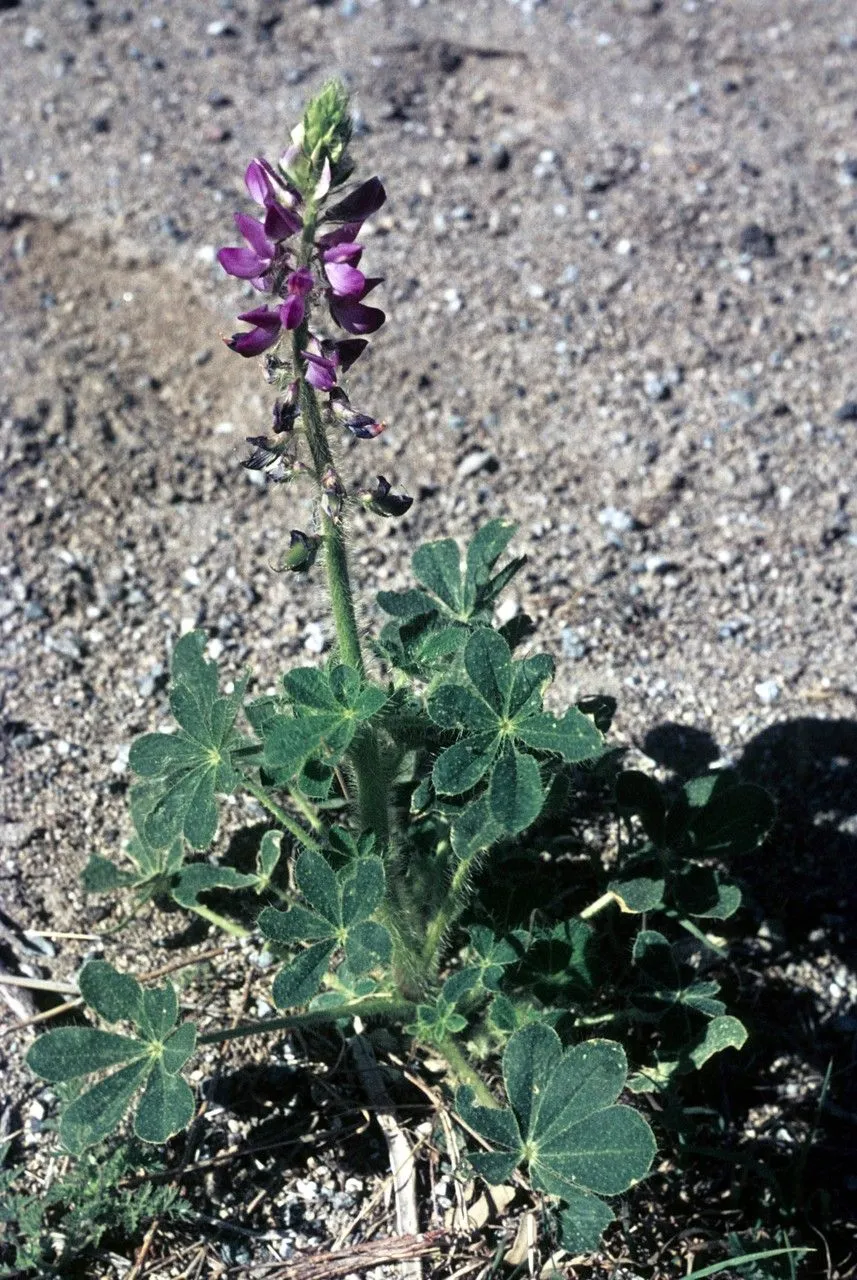
Author: Benth.
Bibliography: Trans. Hort. Soc. London, ser. 2, 1: 411 (1834 publ. 1835)
Year: 1835
Status: accepted
Rank: species
Genus: Lupinus
Vegetable: False
Observations: California to NW. Mexico
Stinging annual lupine, scientifically known as Lupinus hirsutissimus, is a fascinating plant that belongs to the Fabaceae family. First described by Benth. in the early 19th century, particularly in the publication “Trans. Hort. Soc. London, ser. 2, 1: 411,” the species has since intrigued botanists and plant enthusiasts alike.
This remarkable plant is native to a range stretching from California to Northwestern Mexico. Known for its distinct stinging hairs, which can cause mild skin irritation upon contact, the stinging annual lupine demands a bit of caution during observation or handling. Despite this, its striking appearance and ecological importance render it a valuable component of its native ecosystems.
Lupinus hirsutissimus is an annual herbaceous plant, characterized by its hairy stems and deeply lobed leaves. The foliage of this lupine adds to its visual appeal, but it is the vibrant inflorescences that truly captivate attention. The flowers, typically appearing in shades of blue or purple, are borne on dense, upright spikes, creating a dramatic display against the often rugged terrain of their natural habitats.
In addition to its ornamental value, stinging annual lupine plays a vital role in its environment. Like other members of the Fabaceae family, it is capable of fixing nitrogen in the soil through symbiotic relationships with bacteria in its root nodules. This not only benefits the lupine itself but also enriches the soil, promoting the growth of surrounding vegetation.
As an important food source, the stinging annual lupine offers nectar and pollen to various pollinators, including bees and butterflies. These interactions highlight the plant’s contribution to maintaining the biodiversity within its ecosystem.
Despite its somewhat intimidating common name, Lupinus hirsutissimus possesses a unique charm and ecological significance. Its adaptability to the environments spanning from California to Northwestern Mexico ensures that it continues to flourish, offering both beauty and utility to the natural world.
Eng: stinging annual lupine
En: Stinging annual lupine
Taken Jan 25, 1999 by EOL − John Game (cc-by-sa)
Taken Jan 1, 1900 by EOL − Niehaus, T.F. (cc-by-nc-sa)
Taken Jan 31, 2016 by EOL − Keir Morse (cc-by-nc-sa)
Taken Mar 28, 2016 by EOL − Gena Bentall (cc-by-nc)
Taken Mar 31, 2020 by Rey Lambert (cc-by-sa)
Taken Jan 28, 2016 by EOL − Damon Tighe (cc-by-nc)
Taken Jan 1, 1900 by EOL − Niehaus, T.F. (cc-by-nc-sa)
Taken Jan 31, 2016 by EOL − Keir Morse (cc-by-nc-sa)
Taken Mar 31, 2020 by Rey Lambert (cc-by-sa)
Taken Dec 7, 2022 by Felipe Shiguedomi (cc-by-sa)
Taken Jan 1, 1900 by EOL − Niehaus, T.F. (cc-by-nc-sa)
Taken Jan 1, 1900 by EOL − Niehaus, T.F. (cc-by-nc-sa)
Taken Jan 31, 2016 by EOL − Keir Morse (cc-by-nc-sa)
Taken Jan 31, 2016 by EOL − Keir Morse (cc-by-nc-sa)
Taken Jan 31, 2016 by EOL − Keir Morse (cc-by-nc-sa)
Taken Dec 24, 2008 by EOL − Keir Morse (cc-by-nc-sa)
Taken Feb 15, 2010 by EOL − Gary A. Monroe (cc-by-nc)
Taken Dec 24, 2008 by EOL − Keir Morse (cc-by-nc-sa)
Taken Jan 31, 2016 by EOL − Keir Morse (cc-by-nc-sa)
© copyright of the Board of Trustees of the Royal Botanic Gardens, Kew.
Growth habit>: Forb/herb
Family: Myrtaceae Author: (F.Muell.) K.D.Hill & L.A.S.Johnson Bibliography: Telopea 6: 402 (1995) Year: 1995 Status:…
Family: Rubiaceae Author: Pierre ex A.Froehner Bibliography: Notizbl. Bot. Gart. Berlin-Dahlem 1: 237 (1897) Year:…
Family: Sapindaceae Author: Koidz. Bibliography: J. Coll. Sci. Imp. Univ. Tokyo 32(1): 38 (1911) Year:…
Family: Asteraceae Author: A.Gray Bibliography: Pacif. Railr. Rep.: 107 (1857) Year: 1857 Status: accepted Rank:…
Family: Fabaceae Author: Medik. Bibliography: Vorles. Churpfälz. Phys.-Ökon. Ges. 2: 398 (1787) Year: 1787 Status:…
Family: Aspleniaceae Author: (Cav.) Alston Bibliography: Bull. Misc. Inform. Kew 1932: 309 (1932) Year: 1932…